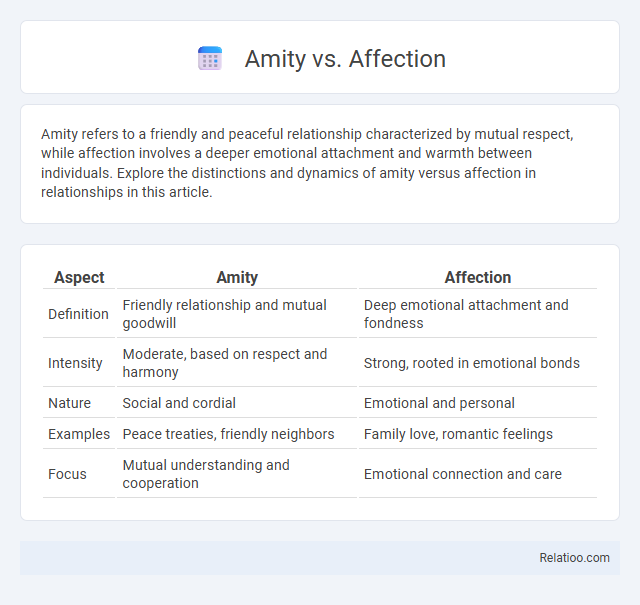Amity refers to a friendly and peaceful relationship characterized by mutual respect, while affection involves a deeper emotional attachment and warmth between individuals. Explore the distinctions and dynamics of amity versus affection in relationships in this article.
Table of Comparison
| Aspect | Amity | Affection |
|---|---|---|
| Definition | Friendly relationship and mutual goodwill | Deep emotional attachment and fondness |
| Intensity | Moderate, based on respect and harmony | Strong, rooted in emotional bonds |
| Nature | Social and cordial | Emotional and personal |
| Examples | Peace treaties, friendly neighbors | Family love, romantic feelings |
| Focus | Mutual understanding and cooperation | Emotional connection and care |
Understanding Amity and Affection
Amity refers to a friendly relationship characterized by mutual goodwill and peace between individuals or groups, often implying harmony without necessarily involving deep emotional bonds. Affection, by contrast, denotes a warm, tender feeling toward someone, highlighting emotional closeness and care in intimate or personal relationships. Understanding the distinction between amity and affection helps you navigate social interactions by recognizing when connections are based on cordial respect versus genuine emotional attachment.
Defining Amity: The Essence of Friendly Relations
Amity represents a peaceful and harmonious relationship characterized by mutual understanding and goodwill, distinct from affection, which conveys deep emotional attachment, and affinity, indicating a natural liking or kinship. Your ability to foster amity promotes a stable foundation for collaboration and trust among individuals or groups. Emphasizing amity nurtures positive social interactions that enhance community cohesion and collective well-being.
What Constitutes Affection?
Affection constitutes genuine feelings of warmth and fondness that you express through physical touch, kind words, or thoughtful actions. Unlike amity, which refers to a friendly and peaceful relationship between individuals or groups, affection is more personal and emotionally intimate. It enhances bonds by creating a deeper sense of closeness and care beyond general goodwill.
Key Differences Between Amity and Affection
Amity refers to a friendly relationship or peaceful harmony between individuals or groups, often implying mutual understanding and goodwill. Affection signifies a deep emotional attachment or fondness, usually expressed through warmth or care towards someone. The key difference lies in amity emphasizing social harmony and mutual respect, whereas affection centers on personal emotions and intimate bonds.
Psychological Roots of Amity and Affection
Amity and affection both arise from deep psychological roots involving trust, empathy, and emotional bonding, yet amity emphasizes a harmonious relationship often grounded in mutual respect and cooperation, while affection reflects a stronger, more intimate emotional attachment. Understanding these distinctions can help you foster healthier social connections by recognizing when emotional closeness (affection) or peaceful goodwill (amity) is most appropriate. The psychological basis of amity lies in social cohesion and group harmony, whereas affection is driven by personal attachment and emotional warmth.
The Role of Amity in Social Dynamics
Amity fosters harmonious relationships by promoting mutual respect and cooperation within communities, enhancing social cohesion and trust. Unlike affection, which is rooted in emotional attachment, amity emphasizes goodwill and peaceful interactions as essential elements of social stability. In social dynamics, amity serves as the foundation for constructive dialogue and conflict resolution, facilitating collective progress and unity.
How Affection Shapes Personal Relationships
Affection plays a crucial role in shaping personal relationships by fostering emotional closeness, trust, and warmth, which strengthens bonds between individuals. Unlike amity, which refers to general friendship or goodwill, affection involves deep feelings of care and attachment that influence your ability to connect and support loved ones on a meaningful level. Understanding the distinction between affection, amity, and friendliness helps you nurture relationships that are both emotionally rich and enduring.
Amity vs Affection: Examples in Daily Life
Amity refers to a friendly, peaceful relationship, often seen in diplomatic or community settings, such as neighbors maintaining amity by cooperating on local projects. Affection involves a deeper emotional bond, frequently expressed through family hugs or romantic gestures that convey warmth and care. In daily life, amity fosters harmony and mutual respect among acquaintances, while affection strengthens personal connections through emotional closeness.
Building Amity and Fostering Affection
Building amity involves creating a foundation of mutual respect and trust that encourages positive relationships within a community or group. Fostering affection focuses on nurturing emotional warmth and genuine care between individuals, enhancing personal bonds and emotional connections. Your efforts to cultivate both amity and affection strengthen social harmony and deepen interpersonal understanding.
Amity and Affection in Literature and Art
Amity in literature and art often symbolizes peaceful relationships and mutual respect between characters or communities, representing harmony and goodwill. Affection, by contrast, conveys warmth, tenderness, and emotional closeness, frequently explored through intimate interactions and expressive gestures in artistic works. While amity emphasizes enduring social bonds and collective harmony, affection highlights personal feelings and individual connections within narratives and visual representations.

Infographic: Amity vs Affection
 relatioo.com
relatioo.com